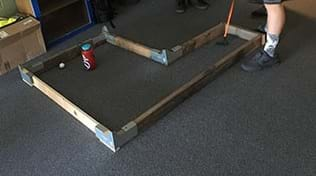Materials List:
Geometry Solutions:
Design and Play Mini-Golf
 https://www.teachengineering.org/activities/view/cub_geotools_lesson01_activity1
https://www.teachengineering.org/activities/view/cub_geotools_lesson01_activity1
Design and Play Mini-Golf
Each group needs:
- protractor
- (optional) Mira
- graph paper and pencils
- straightedge, or ruler with a metal edge
- calculator
- measuring tape
- golf ball (a few can be shared among groups)
- putter (a few can be shared among groups)
- Putt Worksheet, one per student
- Project Requirements and Grading Rubric, one per group
- (optional) computers with Internet access to use GeoGebra to solve problems (instead of paper)
To share with the entire class:
- wood, 2 x 4-inch dimension for hole framing, such as an 8-foot length for ~$3 at Home Depot (see Figure 1); ~16 feet per group
- steel corner joints, ~4 per group, for hole framing, for ~$4 each at Walmart (see Figure 1)
- (if wood is not pre-cut) saw, for cutting wood (for teacher use)
- screws
- drills
Materials note: See Figure 1 for an example student-built mini putt hole made of wood and corner joints. This one-hole mini-putt configuration cost about $22 (~$16 for four joints, ~$6 for wood). Recycled wood and used corner joints work just as well and cost less. To further reduce costs, use hammer and nails instead of steel corner joints, or use duct-taped thick cardboard instead of wood.

 https://www.teachengineering.org/activities/view/cub_geotools_lesson01_activity1
https://www.teachengineering.org/activities/view/cub_geotools_lesson01_activity1